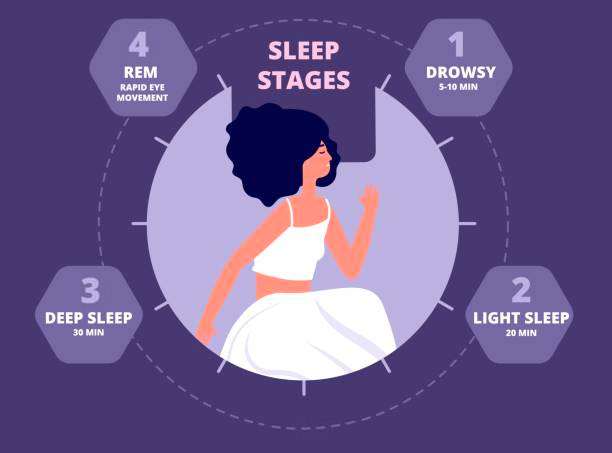The 4 Stages of Sleep
As you fall asleep, your body goes through 4 stages of sleep. Each stage plays an important role in helping you feel rested and refreshed. The entire sleep cycle repeats several times throughout the time you are asleep and usually takes between 90 minutes and 120 minutes to cycle through all four stages of sleep. These are four stages of sleep: Non-Rapid Eye Movement (NREM) Stage I, II, III, and REM (rapid eye movement). Here’s a brief overview of each stage:
NREM Stage I

NREM Stage I: The earliest stage of sleep where you may be still awake.
This is the lightest stage of sleep and may include moments of being awake and alert. You also may be awakened easily during this stage if you have lightly fallen asleep. Your eyes are moving slowly and your muscle activity decreases. You may experience brief episodes of muscle twitching. This stage usually lasts for five to ten minutes. Most people don’t know they’ve entered into stage I sleep because it’s so light. In fact, if you’re awakened during this stage, you may not even remember that you were asleep. However, if you progress from NREM Stage I to NREM Stage II sleep, it’s likely that you’ll become more aware of your surroundings and may even feel like you’re falling asleep.
NREM Stage II

NREM Stage II: Your breathing and heart rate have slowed.
This is a deeper stage of sleep. Your breathing and heart rate are regular, and you may begin to experience brief periods of muscle relaxation. You are not easily awakened during NREM Stage II sleep, but if you are, you may feel disoriented for a moment. It is common to have dreams during this stage of sleep; however, you usually do not remember them upon waking. During NREM Stage II, your brainwaves begin to slow from the mixed frequency waves of NREM Stage I to the slower delta waves of deep sleep. Also in NREM Stage II, your eye movements stop. You spend more time in NREM Stage II sleep than in any other stage of NREM sleep.
According to the American Sleep Foundation, most people spend 50% of their total sleep time in NREM Stage II. Each cycle of REM and NREM sleep lasts about 90 minutes to 120 minutes; therefore, if you sleep for eight hours, you will have about five to six cycles. NREM Stage II sleep is sometimes referred to as light sleep because you can be easily awakened from it. However, your brain and body are working hard during this stage of sleep. Your body temperature begins to drop and your heart rate slows. Many people are surprised to learn that Stage II is not a deep stage of sleep. In fact, it is considered a lighter stage of sleep because you can be easily awakened from it. However, your brain and body are working hard during this stage of sleep.
NREM Stage III

NREM Stage III: The deep stage of sleep where your body begins to repair itself.
This is the deepest stage of sleep. Your breathing and heart rate are slow, and you may experience long periods of muscle relaxation. This is the stage in which you are most likely to experience sleep paralysis and hypnagogic hallucinations. You may also be less likely to be awakened by external noise or movement during this stage of sleep.
This is the stage of sleep when people often experience sleepwalking, night terrors, and bed-wetting. Although these events may seem to happen randomly, they actually occur during slow-wave sleep, which is the deepest stage of NREM sleep.
It is during Stage III that your body begins to repair itself. Your muscles and tissues are repaired, and your immune system is bolstered. This is also the stage in which growth hormone is released, which helps to promote tissue and bone growth. If you are not getting enough deep sleep, you may be at risk for problems with mood, memory, and focus. You may also be more likely to experience anxiety and depression.
REM

REM Stage: When your brain is active but your body is paralyzed.
This is the Rapid Eye Movement stage of sleep. Your brain is active during this stage, and you may experience dreams. Your body is paralyzed during REM sleep, which prevents you from acting out your dreams. REM sleep is important for memory and learning. Your brain consolidates information and memories during this stage of sleep.
If you don’t get enough REM sleep, you may have trouble concentrating or remembering things. REM sleep also plays a role in emotional regulation. Dreams during this stage of sleep can help you process and work through difficult emotions. If you wake up during the REM stage of sleep, you may feel groggy and disoriented. It can be hard to go back to sleep if you’ve been woken up during this stage. REM sleep is a vital part of a healthy sleep cycle. If you’re not getting enough REM sleep, it can be helpful to talk to a doctor or sleep specialist. They can help you identify any underlying causes and develop a plan to improve your sleep.
In Conclusion
These are the four stages of sleep, and each plays an important role in our overall health. The first, the NREM Stage 1 is the beginning of your sleep cycle where you are winding down and begin to fall asleep. Second, NREM Stage II is a light stage of sleep, but your body is still working hard during this stage. Then third, NREM Stage III is the deepest stage of sleep, and it’s during this stage that your body begins to repair itself. Finally, REM sleep is important for memory and learning, and it also plays a role in emotional regulation. If you’re not getting enough proper sleep, talk to a doctor or sleep specialist to see how you can improve your sleep.


